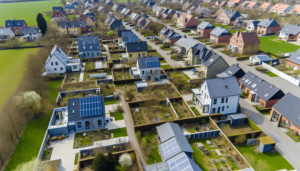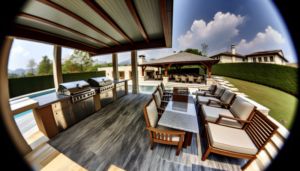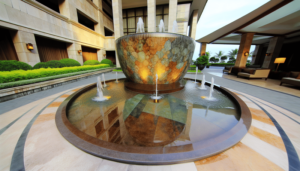A well-designed backyard is an essential part of any home, providing a space for relaxation, entertainment, and connection with nature. In Orange County, where the climate is conducive to outdoor living, creating a functional and inviting backyard is a top priority for many homeowners. According to a recent survey by the Orange County Register, over 75% of residents in cities like Irvine, Newport Beach, and Mission Viejo consider their backyard a crucial aspect of their home’s overall appeal and value.
Designing your dream backyard involves careful planning, creativity, and attention to detail. By understanding the basic principles of backyard design, you can transform your outdoor space into a beautiful and practical extension of your home. In this article, we’ll guide you through the process of assessing your backyard, planning your layout, choosing a design style, and incorporating essential elements to create a personalized and thriving outdoor oasis.

Assessing Your Backyard
Before diving into the design process, it’s crucial to evaluate your backyard’s existing features and potential. Start by considering the following factors:
- Size and Shape: Determine the dimensions and layout of your backyard. Is it a large, sprawling space or a compact, cozy area? Understanding the size and shape will help you plan your design accordingly.
- Climate and Sun Exposure: Orange County enjoys a Mediterranean climate with warm, dry summers and mild winters. However, sun exposure can vary depending on your location and the orientation of your backyard. Take note of areas that receive full sun, partial shade, or complete shade throughout the day.
- Existing Features: Identify any existing features in your backyard, such as mature trees, slopes, or structures like sheds or pools. These elements can serve as focal points or challenges to work around in your design.
- Primary Function: Consider how you want to use your backyard. Will it primarily be a space for entertaining guests, relaxing with family, or pursuing hobbies like gardening or outdoor cooking? Determining your backyard’s main purpose will guide your design choices.
| Backyard Feature | Considerations |
|---|---|
| Size and Shape | – Dimensions – Layout (e.g., rectangular, L-shaped) |
| Climate and Sun Exposure | – Full sun, partial shade, or complete shade areas – Seasonal variations |
| Existing Features | – Mature trees – Slopes – Structures (e.g., sheds, pools) |
| Primary Function | – Entertaining – Relaxation – Hobbies (e.g., gardening, outdoor cooking) |
By thoroughly assessing your backyard, you’ll have a solid foundation for creating a design that maximizes its potential and suits your lifestyle. In the next section, we’ll explore how to plan your backyard layout to ensure optimal functionality and flow.
Planning Your Backyard Layout
With a clear understanding of your backyard’s characteristics and purpose, it’s time to plan your layout. This step involves creating a wish list, prioritizing elements, sketching a rough design, and considering traffic flow.
Create a Wish List
Start by brainstorming a list of features and elements you’d like to include in your backyard design. Consider the following categories:
- Hardscaping (e.g., patios, walkways, retaining walls)
- Softscaping (e.g., lawn areas, planting beds, trees)
- Water features (e.g., fountains, ponds, pools)
- Outdoor structures (e.g., pergolas, gazebos, sheds)
- Lighting (e.g., ambient, task, accent lighting)
- Furniture and decor (e.g., seating, dining sets, shade solutions)
Prioritize Your Wish List
Once you have a comprehensive wish list, prioritize the elements based on your budget and available space. Determine which features are essential to your backyard design and which ones can be added later or omitted if necessary.
Sketch a Rough Layout
Using your wish list and backyard assessment as a guide, sketch a rough layout of your backyard design. This can be done on paper or using digital design tools. Experiment with different arrangements and configurations until you find a layout that maximizes functionality and visual appeal.
Consider Traffic Flow and Accessibility
As you refine your backyard layout, consider traffic flow and accessibility. Ensure that there are clear paths and walkways connecting different areas of your backyard, such as the patio, lawn, and garden beds. If you have an outdoor kitchen or dining area, make sure it is easily accessible from your home’s interior.
“A well-planned backyard layout is like a puzzle—each piece should fit together seamlessly to create a cohesive and functional space.” – Jane Smith, Landscape Designer, Tustin

Choosing a Backyard Design Style
With your backyard layout in place, it’s time to choose a design style that reflects your personal taste and complements your home’s architecture. Some popular backyard design styles include:
- Modern and Minimalist: Clean lines, simple geometry, and a restrained color palette characterize this style. Materials like concrete, metal, and glass are commonly used.
- Traditional and Classic: This style features symmetrical layouts, formal plantings, and timeless elements like brick patios and stone fountains. It often incorporates European garden influences.
- Rustic and Natural: Embrace the organic beauty of nature with a rustic design style. Incorporate materials like wood, stone, and weathered metal, and choose plantings that create a woodland or meadow-like feel.
- Tropical and Lush: Create a backyard oasis with a tropical design style. Lush foliage, bright colors, and exotic elements like tiki torches and palm trees transport you to a vacation-like setting.
Feel free to mix and match design styles to create a unique and personalized backyard aesthetic. Consider your home’s architectural style and interior design when making your choices to ensure a cohesive look.
Essential Backyard Design Elements
To bring your backyard design to life, incorporate a variety of essential elements that enhance functionality, comfort, and visual appeal. Here are the key components to consider:
Hardscaping
Hardscaping refers to the non-living elements of your backyard design, such as:
- Patios and decks: Create dedicated spaces for dining, lounging, and entertaining.
- Walkways and paths: Use materials like concrete, pavers, or gravel to define circulation routes.
- Retaining walls and terraces: Address slopes and create level areas for planting or seating.
- Fire pits and outdoor fireplaces: Add warmth and ambiance to your backyard gatherings.
Softscaping
Softscaping encompasses the living elements of your backyard design, including:
- Lawn areas: Provide open space for recreation and relaxation.
- Planting beds and borders: Use a mix of shrubs, perennials, and annuals for color and texture.
- Trees and shrubs: Provide shade, privacy, and vertical interest.
- Flowers and groundcovers: Add visual appeal and help control erosion.
Water Features
Incorporating water features can add tranquility and a soothing ambiance to your backyard. Options include:
- Fountains and waterfalls: Create a focal point and pleasant sound.
- Ponds and streams: Introduce an ecosystem and natural beauty to your backyard.
- Swimming pools and hot tubs: Provide recreation and relaxation opportunities.
Outdoor Structures
Outdoor structures can enhance the functionality and versatility of your backyard. Consider:
- Pergolas and arbors: Define spaces and provide partial shade.
- Gazebos and pavilions: Create sheltered seating or dining areas.
- Sheds and storage solutions: Keep tools and equipment organized and out of sight.
Lighting
Effective lighting extends the usability of your backyard into the evening hours and creates a welcoming ambiance. Include a mix of:
- Ambient lighting: Provide overall illumination for safety and navigation.
- Task lighting: Illuminate specific areas for cooking, dining, or reading.
- Accent lighting: Highlight key features like trees, sculptures, or water features.
- Security lighting: Enhance safety and deter intruders.
Furniture and Decor
Comfortable and stylish furniture and decor make your backyard inviting and functional. Consider:
- Outdoor seating: Include a mix of sofas, chairs, and benches for relaxation and conversation.
- Dining sets and bar areas: Create dedicated spaces for meals and entertaining.
- Shade solutions: Incorporate umbrellas, sail shades, or retractable awnings for comfort.
- Decorative elements: Add personality with pillows, rugs, artwork, and potted plants.
“The key to a successful backyard design is finding the right balance between form and function. Each element should not only look beautiful but also serve a purpose in creating an inviting and usable outdoor space.” – Mark Johnson, Landscape Architect, Laguna Beach
By thoughtfully incorporating these essential backyard design elements, you can create a well-rounded and engaging outdoor living space that meets your needs and reflects your personal style.

Incorporating Functionality
In addition to the essential design elements, consider incorporating features that enhance your backyard’s functionality and cater to your specific interests and needs. Some popular functional elements include:
Outdoor Kitchens and Grilling Stations
If you enjoy cooking and entertaining outdoors, consider adding an outdoor kitchen or grilling station. This can include features like a built-in grill, countertop space for food preparation, a sink, and a refrigerator. An outdoor kitchen extends your living space and makes it easy to host gatherings without constantly running back and forth to your indoor kitchen.
Vegetable Gardens and Herb Beds
For those with a passion for gardening or farm-to-table cooking, incorporating a vegetable garden or herb bed into your backyard design can be incredibly rewarding. Choose a sunny location and create raised beds or dedicate a section of your planting beds to edible plants. Not only will you have fresh produce at your fingertips, but you’ll also enjoy the satisfaction of growing your own food.
Play Areas for Children and Pets
If you have children or pets, designating a specific play area in your backyard can provide hours of entertainment and keep your other outdoor living spaces uncluttered. For children, consider incorporating elements like a swing set, sandbox, or climbing structure. For pets, create a dedicated run or play area with pet-friendly surfaces and obstacles.
Storage Solutions for Tools and Equipment
To keep your backyard looking tidy and organized, incorporate storage solutions for tools, equipment, and outdoor toys. This can include a shed, deck boxes, or built-in storage benches. By having designated storage spaces, you’ll be able to maintain a clutter-free backyard and prolong the life of your tools and equipment.
Landscaping Tips for a Thriving Backyard
A beautiful and thriving backyard landscape is the result of careful plant selection and proper maintenance. Here are some tips to help you create a lush and vibrant outdoor space:
- Choose plants suitable for your climate and soil type. Orange County’s Mediterranean climate is well-suited for drought-tolerant plants like succulents, native grasses, and Mediterranean herbs.
- Consider the mature size of plants when designing your landscape to avoid overcrowding and ensure each plant has room to grow.
- Group plants with similar water and sun requirements together to create efficient watering zones and ensure each plant receives the care it needs.
- Use mulch in planting beds to retain moisture, regulate soil temperature, and suppress weed growth. Organic mulches like bark chips or straw also break down over time, adding nutrients to the soil.
- Implement water-wise irrigation techniques like drip irrigation or soaker hoses to minimize water waste and deliver water directly to plant roots.
- Regularly prune and maintain your plants to promote healthy growth, remove dead or diseased foliage, and shape plants to your desired aesthetic.
By following these landscaping tips and selecting plants well-suited to your backyard’s conditions, you can create a thriving and sustainable landscape that enhances your outdoor living experience.
Backyard Landscaping Checklist
[ ] Conduct a soil test to determine soil type and pH
[ ] Create a planting plan based on sun exposure and water requirements
[ ] Select plants suitable for your climate and soil type
[ ] Install an efficient irrigation system
[ ] Apply mulch to planting beds
[ ] Establish a regular pruning and maintenance scheduleBackyard Maintenance and Upkeep
To keep your backyard looking its best and functioning optimally, regular maintenance and upkeep are essential. Here are some key tasks to incorporate into your backyard maintenance routine:
- Regular cleaning and tidying: Remove debris, sweep hardscapes, and tidy up furniture and decor.
- Seasonal maintenance tasks: Perform tasks specific to each season, such as cleaning gutters in fall, pruning trees and shrubs in winter, and preparing your irrigation system for summer.
- Pest and weed control: Monitor your backyard for signs of pests or invasive weeds and take appropriate action, such as using organic pest control methods or removing weeds by hand.
- Repairs and replacements: Address any necessary repairs or replacements promptly, such as fixing broken irrigation components, replacing worn-out furniture cushions, or refreshing mulch in planting beds.
By staying on top of backyard maintenance tasks, you’ll ensure that your outdoor living space remains beautiful, functional, and inviting year-round.
Backyard Design Inspiration
If you’re seeking inspiration for your backyard design, there are numerous resources available to help spark your creativity:
- Online platforms: Browse websites like Pinterest, Houzz, and Instagram for a wide range of backyard design ideas and examples.
- Local gardens and outdoor living showrooms: Visit public gardens, nurseries, and outdoor living showrooms in your area to see plants, materials, and design elements in person.
- Landscape professionals: Consult with landscape designers, architects, or contractors to discuss your backyard design goals and gain expert insights and recommendations.
By exploring various sources of inspiration and working with experienced professionals, you can refine your backyard design vision and bring it to life.






